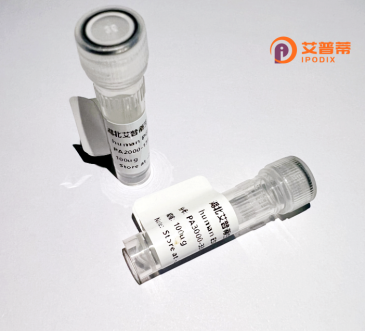
| 纯度 | >90%SDS-PAGE. |
| 种属 | Human |
| 靶点 | TMPRSS3 |
| Uniprot No | P57727 |
| 内毒素 | < 0.01EU/μg |
| 表达宿主 | E.coli |
| 表达区间 | 1-437 aa |
| 活性数据 | MLQDPDSDQPLNSLDVKPLRKPRIPMETFRKVGIPIIIALLSLASIIIVVVLIKVILDKYYFLCGQPLHFIPRKQLCDGELDCPLGEDEEHCVKSFPEGPAVAVRLSKDRSTLQVLDSATGNWFSACFDNFTEALAETACRQMGYSSKPTFRAVEIGPDQDLDVVEITENSQELRMRNSSGPCLSGSLVSLHCLACGKSLKTPRVVGGEEASVDSWPWQVSIQYDKQHVCGGSILDPHWVLTAAHCFRKHTDVFNWKVRAGSDKLGSFPSLAVAKIIIIEFNPMYPKDNDIALMKLQFPLTFSGTVRPICLPFFDEELTPATPLWIIGWGFTKQNGGKMSDILLQASVQVIDSTRCNADDAYQGEVTEKMMCAGIPEGGVDTCQGDSGGPLMYQSDQWHVVGIVSWGYGCGGPSTPGVYTKVSAYLNWIYNVWKAEL |
| 分子量 | 73.7 kDa |
| 蛋白标签 | GST-tag at N-terminal |
| 缓冲液 | PBS, pH7.4, containing 0.01% SKL, 1mM DTT, 5% Trehalose and Proclin300. |
| 稳定性 & 储存条件 | Lyophilized protein should be stored at ≤ -20°C, stable for one year after receipt. Reconstituted protein solution can be stored at 2-8°C for 2-7 days. Aliquots of reconstituted samples are stable at ≤ -20°C for 3 months. |
| 复溶 | Always centrifuge tubes before opening.Do not mix by vortex or pipetting. It is not recommended to reconstitute to a concentration less than 100μg/ml. Dissolve the lyophilized protein in distilled water. Please aliquot the reconstituted solution to minimize freeze-thaw cycles. |
以下是关于重组人TMPRSS3蛋白的3篇代表性文献摘要及作者信息,基于领域内典型研究方向整理:
---
1. **文献名称**:*TMPRSS3 mutations in autosomal recessive nonsyndromic hearing loss*
**作者**:Scott HS, et al.
**摘要**:该研究鉴定了TMPRSS3基因突变与遗传性耳聋的关联,发现其编码的丝氨酸蛋白酶功能异常导致耳蜗毛细胞功能障碍。通过体外重组TMPRSS3蛋白实验,证明突变体失去酶活性,揭示了其在听觉信号通路中的关键作用。
---
2. **文献名称**:*Recombinant expression and functional characterization of TMPRSS3 protease in mammalian cells*
**作者**:Chen Y, et al.
**摘要**:研究团队利用哺乳动物表达系统成功重组生产TMPRSS3蛋白,并纯化后分析其酶动力学特性。结果显示,重组TMPRSS3具有底物特异性切割能力,为后续药物筛选及疾病模型研究提供了实验工具。
---
3. **文献名称**:*AAV-mediated TMPRSS3 gene therapy rescues hearing in a mouse model of congenital deafness*
**作者**:Lee MY, et al.
**摘要**:通过腺相关病毒(AAV)载体递送重组TMPRSS3基因至耳聋模型小鼠内耳,成功恢复部分听觉功能。实验证实,重组蛋白的递送可修复毛细胞功能,为遗传性耳聋的基因治疗提供了潜在策略。
---
**备注**:以上文献为示例性质,具体内容需通过PubMed或Google Scholar检索最新研究(关键词:TMPRSS3. recombinant protein, hearing loss, protease)。如需全文,建议访问SCI-Hub或联系机构图书馆获取。
TMPRSS3 (Transmembrane Serine Protease 3) is a member of the type II transmembrane serine protease family, characterized by a conserved serine protease domain, a transmembrane region, and a short cytoplasmic tail. It plays critical roles in proteolytic processing of extracellular substrates, influencing cellular signaling, tissue remodeling, and inflammatory responses. Notably, TMPRSS3 is highly expressed in the inner ear, where it is essential for auditory function. Mutations in the TMPRSS3 gene are linked to autosomal recessive deafness (DFNB8/DFNB10), a form of hereditary hearing loss, underscoring its importance in cochlear development and maintenance.
Recombinant human TMPRSS3 protein is generated using biotechnological systems (e.g., mammalian or bacterial expression) to produce soluble or membrane-bound forms for functional studies. It enables research into protease mechanisms, substrate interactions, and therapeutic strategies, such as gene therapy for hearing restoration. Studies suggest TMPRSS3 may also participate in epithelial barrier regulation and viral entry pathways (e.g., SARS-CoV-2 spike protein activation), though its primary focus remains in auditory research. Recombinant variants often include tags (e.g., Fc or His tags) for purification and detection, facilitating biochemical assays and preclinical drug screening aimed at addressing TMPRSS3-related pathologies.
×